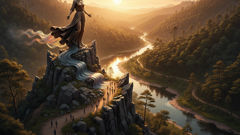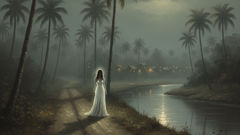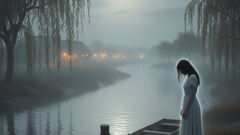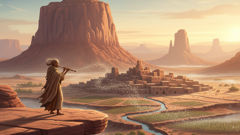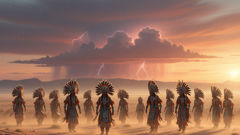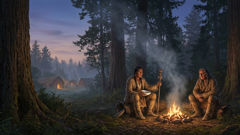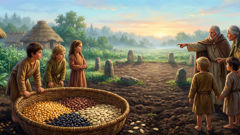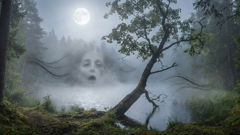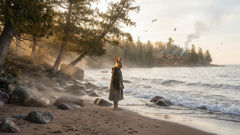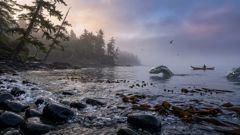Introduction
The giants of Norse myth are not merely colossal opponents to the gods; they are the older grammar of the world itself. In the fjords, on the scree of Norway’s mountains and the black beaches that face the North Atlantic, storytellers once felt in wind and stone the same stubborn logic the sagas name Jötunn: raw, older forces that resist, reshape, and sometimes beget what the Aesir claim as order. To listen to their stories is to read the landscape back into myth—to see glaciers as the bones of a slain primeval being, to hear winter’s everyfootstep as the tread of frost-born kin, to watch marriage as a treaty between storm and hearth. This long piece gathers several of those specific tales and walks with them: Ymir, whose body built the world; Bergelmir, who survives the flood of blood and becomes ancestor to later giants; Thjazi, who hatches a crisis by carrying Idunn away; Thrym, who revenges his aloof place with a brazen theft; Skadi, who chooses a husband by his feet and later refuses to be comforted in courts of the sea; and the riddles of Utgard-Loki, where deception itself is a kind of law. I aim neither to simplify nor to romanticize these tales. Instead, I want to show the Jötunn as they appear in the Norse imagination: elemental antagonists, ambiguous kin, and indispensable mirrors to the gods. Each story is retold with attention to place—Norway’s cliffs and fjords—along with context: how these narratives answered questions about origins, hospitality, marriage, and the fragile bargains that hold the cosmos together.
Origins and the Flooded Bones: Ymir, Bergelmir, and the Birth of Worlds
The oldest story of the Jötunn is also the most foundational: the birth and death of Ymir, whose body becomes the stage on which gods and mortals will play. In the cold vastness before the world, Norse cosmogony places a yawning gap between fire and ice—Muspelheim and Niflheim—filled with a mist where heat met frost. Within that threshold a first being is formed, an ungainly, primordial entity that poets later name Ymir. He is at once producer and produced: he sweats new life in the conflux of elements, and from him the race of frost giants emerges. The giants, then, are not afterthoughts but participants in creation, the first shapes to appear within the roiling crucible of being.

The tale continues bitterly. Odin and his brothers—names vary in sources, but often given as Odin, Vili, and Vé—rise as a later generation, divinities who claim order and structure. They do not merely negotiate with Ymir; they slay him. There is something holy and ferocious in that moment: the killing of what came before to make way for world-making. The mythology records a kind of proto-violence as cosmic crafting—Ymir’s blood floods out and becomes the seas; his flesh forms earth; his bones are the mountains; his teeth and stony fragments become rocks and rubble; his skull forms the sky, held aloft by dwarf-supporting pillars. Even the gods’ triumph is an act of transformation: the body of the giant is parcelled into architecture, a sculpture that becomes the environment of human life. That image—landscape as a repurposed body—anchors the Jötunn not only as antagonists but as materials of cosmos and culture.
Yet the story insists the giants survive. Bergelmir is the name that threads through the sagas: a giant who endures the flood of Ymir’s blood in a hollowed trunk or a big boat. While many giants drown, Bergelmir and his spouse float—what follows is not just survival but continuity. From them flows another seed of Jötunn kin, an assurance that the old world persists in some line. This is more than a mythic footnote; it shows a worldview invested in cycles and restitutions. The gods may monopolize cities, law, and the forging of tools, but the old line maintains a foothold in the watery places where rock confronts ocean. Bergelmir’s boat becomes a lyric symbol for how life adapts: flood does not finish the giants, and their presence in the margins of the world is perpetual and recursive.
Across Norway, the geology validates that way of thinking. When I stand on coastal basalt, watching tide water tick and then pour, it is easy to imagine that the sea still remembers the first downpour of blood, that the cliffs are the ribs of an elder, and that the fjords themselves have patient giant memories. Poets in the sagas hint at this when they make the Jötunn friends of ice and sea. Frost giants live in glaciers and in caves at the fringe of human habitation because those terrains match the scale and temperament of primordial beings. Their homes are outside regulated spaces; they ask for different rules.
That tension—between being material to the world and being uneasily other—is why the death of Ymir is not a moral condemnation but a metamorphosis. The gods build halls and laws out of his remains; the Jötunn’s legacy is literally baked into the mountains and tides. The later interactions, then—raids, marriages, trickery—are less a binary of good and evil than ongoing negotiations over what the world will be. Bergelmir’s survival complicates the seeming triumph of order: from the old blood new giants emerge, and some of them will become the protagonists of the stories that follow. To read these origin tales in Norway’s landscape is to see an ethic of respect: the giants are ancient conditions of existence, stubborn forces whose refusal to disappear means the gods must work around them, bargain, borrow, steal, and sometimes fall under their own hubris.
The saga poets do not treat this cosmological violence as merely abstract. They attach to it consequences, genealogies and curses, families that cross the boundary between Aesir and Jötunn. Through marriages, hostilities, and births—especially the monstrous offspring that spring from some unions—the old order persists in the arteries of the new. Consider the later figure of Skadi, whose lineage traces back to these older stocks, or Angrboða, whose children become weapons of fate. The origin myth thereby gives moral texture to the rest of the narratives: the gods owe the giants shaping power, and some debts are paid in riddles instead of coin.
In several Old Norse poems, the world’s geography is recited as a litany of pieces taken from a primeval corpse. This is not macabre ornamentation; it is a cosmological claim of interdependence. The giants remain a necessary other—mountains and seas, now domesticated into named places and regulated by law, carry the traces of an older anatomy. To walk Norway’s coasts with that story in mind is to sense the Jötunn underfoot and overhead: an unextinguished presence that always threatens to return simply by the force of thaw and surge.
Encounters, Trickery, and Marriages: Thjazi, Thrym, Skadi, and Utgard-Loki
If the origin stories explain where giants belong in the world, the smaller, sharper tales show how they press against human and divine orders. One of the most dramatic of these tales concerns Thjazi and the goddess Idunn. Idunn keeps the apples of youth—objects of life-renewal for the gods. When Loki, bound by trickery and threat, lures Idunn from her safe place and delivers her to Thjazi, the gods suddenly age. In many ways, the episode is a moral about hospitality and the fragility of divine maintenance: a single breach in trust—an abduction—threatens to unmake the structures the gods oversee. Thor’s eventual slaying of Thjazi reasserts divine power, but not without complication. Thjazi’s death causes other fallout: the giant’s daughter Skadi comes to Asgard demanding vengeance.
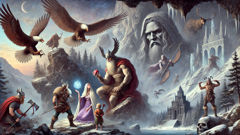
Skadi’s arrival is a study in liminality. She comes armed, an archer-woman from the mountains, and the gods must negotiate compensation. These negotiations are revealing for how the mythology treats cross-cultural bargaining. The gods promise marriage to a god as reparation, but Skadi is stubborn: she will choose her husband not by sight but by the appearance of his feet. Her choice—Njord, the sea god—makes for a mismatched pair because she is born to the high peaks while Njord belongs to the tides. Their marriage is brief and fractious; they cannot live in each other’s homes without resentment. This story resounds with human experience: marriages of alliance often compress irreconcilable habitats and expectations. Skadi’s refusal to yield gracefully is not villainous; it marks the dignity of a mountain-born being who will not be tamed into hearthly comfort.
Parallel to marital unease are stories of theft and audacity. The giant Thrym demonstrates how giants can engineer humiliation as revenge. In a memorable poem, Thrym steals Thor’s hammer, Mjölnir, and buries the Aesir’s power in the earth, demanding the goddess Freyja as bride in exchange. The gods are forced into a cunning response: Thor disguises himself as Freyja to reclaim his hammer, with Loki as an accomplice. The scene where Thor, in bridal dress, seethes beneath the bridal veil is comic and horrifying at once. When Mjölnir is finally revealed and Thor’s strength unleashed, Thrym is killed, but the tale keeps its teeth. It shows that giants can subvert not just force but social forms—weddings, vows, and symbols—turning them into traps. The gods’ recovery of the hammer is a return to cosmic balance, but the memory of the theft is a reminder that no symbol is invulnerable to outside cunning.
The theme of clevering the gods appears vividly in the episode of Utgard-Loki and his hall, which Thor and Loki visit on a voyage. There the two gods are tested with impossible challenges: Thor attempts to lift a cat (actually the Midgard-serpent in disguised measure), wrestles an old woman who is time itself, and drinks from a horn connected to the sea. Each contest, when revealed later, is a trick: Thor’s cat was the world-serpent, the old woman is old age, and the drinking-horn is connected to the measure of the ocean. Utgard-Loki’s tests are less about brute power than demonstration: giants possess perspectives that make gods’ strengths appear narrow. In those halls, what passes for triumph among the Aesir is reframed as temporary, conditioned by particular definitions and illusions. The tale is a meditation on scale and perception: what seems possible in Asgard may be laughably small in Utgard.
There is also a deeper genealogical mischief embedded in the giants’ unions with gods and mortals. Angrboða, a giantess of the Ironwood, becomes the mother of dangerous progeny—Fenrir the wolf, Jörmungandr the world-serpent, and Hel the ruler of the underworld. Each of her children is bound to a prophecy that troubles the gods to their core: Fenrir will break his bonds at Ragnarök; Jörmungandr will rear and bite his tail, signaling the end; Hel will command the dead. The presence of these creatures in the gods’ midst makes prophecy into a family matter. It reveals a Norse logic where kinship links fate and responsibility: when gods take Jötunn kin into their spheres—through wedlock, child-bearing, or hospitality—they also import dangers, debts, and memorials of earlier ages.
Finally, Loki’s complicated relationships with giants thread many of these tales. He is both Aesir companion and, through blood and lovers, kin to the Jötunn. His role as liminal trickster allows stories to cross species boundaries and to interrogate the definitions of loyalty. Loki’s shapeshifting, his betrayals and rescues, culminate in episodes where he is as much an instrument of the giants’ aims as he is their foil. The result is a world where boundaries are porous and every relationship—marriage, feud, fosterage, exchange—carries the possibility of cosmic consequence.
Taken together, these stories show the Jötunn as complex agents: they are destroyers but also ancestors and lawmakers in their own right. In Norwegian landscape terms, they are the weather, the avalanche, the rockfall and the sea-surge that redraw the coastline. They provoke, they bargain, and sometimes they marry; they are phenomena that must be negotiated with rather than simply destroyed. The sagas preserve this ambiguity, giving the giants arcs of grief, vengeance, and even a kind of stern honor. Whether a giant is an aggressor who abducts Idunn or a mother whose children become prophecies, the narrative frames the giants as both necessary other and persistent counterargument to divine complacency.
Conclusion
The Jötunn, in the end, are neither simple villains nor mere background. They are elemental partners in a northern philosophy that sees the world as assembled through exchange—through theft and bargain, through marriage and blood. From Ymir’s body to Bergelmir’s boat, from Thjazi’s abduction to Thrym’s audacious theft and Skadi’s mountain pride, each tale shows giants as forms of resistance: resistances to domestication, to settled law, and to the arrogance of gods who assume their order is permanent. Giants are where the margins press inward; they remind every audience that borders are active, not passive. They are the weather that will not be comforted by invocations of law, the rock that contains older narratives than any city’s founding myths, the genealogical knot that ties fate to family. Norse poets wrote them into being because the world in Norway—its fjords, glaciers, and coasts—tells the same stories in stone and sway. To read the Jötunn is to read the landscape and to accept that any order we make rests on older, larger forces that might one day assert themselves again. Those stories endure because they map the uneasy, bargaining relationship humans and gods have always had with the wild, and because they let us imagine the world as braided from many kinds of life—some of which will always remain a little beyond our reach.


